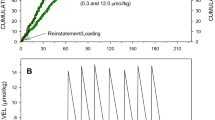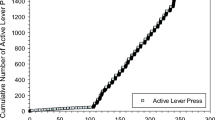Abstract
The present study was designed to investigate parameters and quantitative analysis of cocaine self-administration under a progressive-ratio (PR) schedule of reinforcement, with the goal of enhancing the resolution of PR schedules for measuring reinforcing efficacy. Six rhesus monkeys were prepared with chronic intravenous catheters and trained to self-administer cocaine under a PR schedule. The schedule consisted of five components, each made up of four trials (i.e., 20 trials total). Each trial within a component had the same response requirement. Three initial response requirements were tested: fixed-ratio (FR) 60, FR 120 and FR 240. The response requirements doubled in successive components to a maximum of FR 960, FR 1920 or FR 3840, respectively, in the fifth component. A trial ended with an injection or the expiration of a 12- or 24-min limited hold (LH). The inter-trial interval (ITI) was 15 or 30 min. Four dependent measures were assessed: break point (last FR completed), injections/session, responses/session and response rate (responses/s). For the three initial FRs, the break point, number of injections/session, responses/session and rate increased with dose of cocaine (0.013–0.1 mg/kg per injection) at both ITI/LH values. At the ITI15/LH12, responding decreased at higher doses, i.e., the dose-response functions were biphasic. In contrast, at the ITI30/LH24, responding reached an asymptote at higher doses. In general, cocaine maintained significantly higher break points, injections/session, responses/session and rate at ITI30/LH24 than at ITI15/LH12. However, at both ITI/LHs, as initial FR was increased, injections/session at the higher doses decreased while break point, total responses/session and rate did not change. A ceiling on performance, as assessed by break point, total responses/session and response rate, may have limited the number of cocaine injections an animal could take in a session. The results of this study indicate that optimal conditions for measuring the reinforcing efficacy of cocaine were obtained at the longer ITI/LH and at initial FRs above 60.
Similar content being viewed by others
References
Bedford JA, Bailey LP, Wilson MC (1978) Cocaine-reinforced progressive-ratio performance in the rhesus monkey. Pharmacol Biochem Behav 9: 631–638
Depoortere RY, Li DH, Lane JD, Emmett-Oglesby MW (1993) Parameters of self-administration of cocaine in rats under a progressive-ratio schedule. Pharmacol Biochem Behav 45: 539–548
Griffiths RR, Findley JD, Brady JV, Dolan-Gutcher K, Robinson WW (1975) Comparison of progressive-ratio performance maintained by cocaine, methylphenidate and secobarbital. Psychopharmacologia 43: 81–83
Griffiths RR, Brady JV, Snell JD (1978) Progressive-ratio performance maintained by drug infusions: Comparison of cocaine, diethylpropion, chlorphentermine, and fenfluramine. Psychopharmacology 56: 5–13
Griffiths RR, Bradford LD, Brady JV (1979) Progressive-ratio and fixed-ratio schedules of cocaine-maintained responding in baboons. Psychopharmacology 65: 125–136
Hodos W (1961) Progressive-ratio as a measure of reward strength. Science 134: 943–944
Hodos W (1965) Motivational properties of long durations of rewarding brain stimulation. J Comp Physiol Psychol 59: 219–224
Hoffmeister F (1979) Progressive-ratio performance in the rhesus monkey maintained by opiate infusions. Psychopharmacology 62: 181–186
Huyn H, Feldt LS (1976) Estimation of the Box correction for degrees of freedom for sample data in randomized block and split-plot designs. J Edu Stat 1: 69–82
Johanson CE, Balster RL (1978) A summary of results of a drug self-administration study using substitution procedures in rhesus monkeys. Bull Narc 30: 43–54
Johanson CE, Schuster CR (1975) A choice procedure for drug reinforcers: cocaine and methylphenidate in the rhesus monkey. J Pharmacol Exp Ther 193: 676–688
Jones CA, LeSage M, Sundby S, Poling A (1995) Effects of cocaine in pigeons responding under a progressive-ratio schedule of food delivery. Pharmacol Biochem Behav 50: 527–531
Katz JL (1990) Models of relative reinforcing efficacy and their predictive utility. Behav Pharmacol 1: 283–301
Kirk, RE (1982) Experimental design: procedures for the behavioral sciences, 2nd edn. Brooks/Cole Belmont, Calif.
Nader MA, Woolverton WL (1991) Effects of increasing the magnitude of an alternative reinforcer on drug choice in a discretetrials choice procedure. Psychopharmacology 105: 169–174
Risner ME, Silcox DL (1981) Psychostimulant self-administration by beagle dogs in a progressive-ratio paradigm. Psychopharmacology 75: 25–30
Roberts DCS (1993) Self-administration of GBR 12909 on a fixed ratio and progressive ratio schedule in rats. Psychopharmacology 111: 202–206
Roberts DCS, Loh EA, Vickers G (1989) Self-administration of cocaine on a progressive-ratio schedule in rats: dose-response relationship and effect of haloperidol pretreatment. Psychopharmacology 97: 535–538
Schuster CR, Thompson T (1969) Self-administration of and behavioral dependence on drugs. Annu Rev Pharmacol 9: 483–502
Skjoldager P, Winger G, Woods JH (1991) Analysis of fixed-ratio behavior maintained by drug reinforcers. J Exp Anal Behav 56: 331–343
Spear DJ, Katz JL (1991) Cocaine and food as reinforcers: effects of reinforcer magnitude and response requirement under second-order fixed-ratio and progressive-ratio schedules. J Exp Anal Behav 56: 261–275
Winger G, Woods JH (1985) Comparison of fixed-ratio and progressive-ratio schedules of maintenance of stimulant drug-reinforced responding. Drug Alcohol Depend 15: 123–30
Woodward JJ, Compton DM, Balster RL, Martin, BR (1995) In vitro and in vivo effects of cocaine and selected local anesthetics on the dopamine transporter. Eur J Pharmacol 277: 7–13
Woolverton WL (1995) Comparison of the reinforcing effects of cocaine and procaine in rhesus monkeys responding under a progressive-ratio schedule. Psychopharmacology 120: 296–302
Woolverton WL, Johanson CE (1984) Preference in rhesus monkeys given a choice between cocaine andd,l-cathinone. J Exp Anal Behav 41: 35–43
Author information
Authors and Affiliations
Rights and permissions
About this article
Cite this article
Rowlett, J.K., Woolverton, W.L., Massey, B.W. et al. Parametric analysis of cocaine self-administration under a progressive-ratio schedule in rhesus monkeys. Psychopharmacology 125, 361–370 (1996). https://doi.org/10.1007/BF02246019
Received:
Revised:
Issue Date:
DOI: https://doi.org/10.1007/BF02246019




